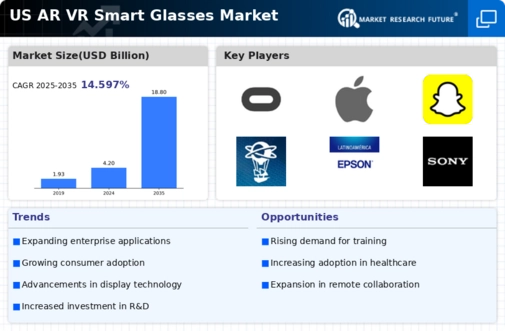Expansion of 5G Networks and Connectivity
The expansion of 5G networks is poised to have a transformative impact on the ar vr-smart-glasses market. With significantly higher data transfer speeds and lower latency, 5G technology enables more robust and responsive applications, enhancing the overall user experience. This connectivity allows for real-time data processing and seamless integration of AR and VR applications, which is crucial for applications in gaming, remote assistance, and live streaming. As 5G coverage continues to grow across the US, the market for ar vr-smart-glasses is likely to see increased adoption, as consumers and businesses alike seek to capitalize on the enhanced capabilities offered by this next-generation network.
Rising Demand for Enhanced User Experiences
Consumer expectations for immersive and interactive experiences are rising, significantly impacting the ar vr-smart-glasses market. Users are increasingly seeking devices that offer seamless integration with their daily activities, such as navigation, gaming, and social interactions. This demand is reflected in the growing popularity of augmented reality applications, which enhance real-world experiences. Market data indicates that the revenue generated from AR applications is expected to reach $100 billion by 2027, further fueling the growth of the ar vr-smart-glasses market. Companies are responding by developing user-friendly interfaces and applications that cater to diverse consumer needs, thereby enhancing overall user satisfaction and driving market expansion.
Growing Interest from Enterprises and Industries
The ar vr-smart-glasses market is witnessing heightened interest from various enterprises and industries seeking to leverage augmented and virtual reality for operational efficiency. Sectors such as manufacturing, logistics, and retail are increasingly adopting smart glasses for training, maintenance, and customer engagement. For instance, studies indicate that companies utilizing AR solutions can improve productivity by up to 40%. This trend suggests that businesses recognize the potential of smart glasses to enhance workflows and reduce costs. As more industries integrate these technologies into their operations, the ar vr-smart-glasses market is expected to expand significantly, driven by enterprise demand.
Increased Investment in Research and Development
Investment in research and development (R&D) is a critical driver for the ar vr-smart-glasses market. Companies are allocating substantial resources to innovate and improve product offerings, focusing on features such as battery life, comfort, and functionality. This trend is evident as major tech firms have increased their R&D budgets by over 30% in recent years, aiming to create next-generation smart glasses that can outperform existing models. Such investments not only enhance product quality but also stimulate competition within the industry, leading to a wider variety of options for consumers. Consequently, the ar vr-smart-glasses market is likely to benefit from continuous innovation and improved product differentiation.
Technological Advancements in Display and Processing
The ar vr-smart-glasses market is experiencing a surge due to rapid technological advancements in display and processing capabilities. Innovations such as OLED and microLED technologies enhance visual clarity and reduce power consumption, making devices more appealing to consumers. Furthermore, improvements in processing power, driven by advancements in AI and machine learning, enable more complex applications and smoother user experiences. As a result, the market is projected to grow at a CAGR of approximately 25% over the next five years, indicating a robust demand for high-performance smart glasses. This trend suggests that manufacturers are increasingly focusing on integrating cutting-edge technologies to meet consumer expectations, thereby driving the ar vr-smart-glasses market forward.

























Leave a Comment